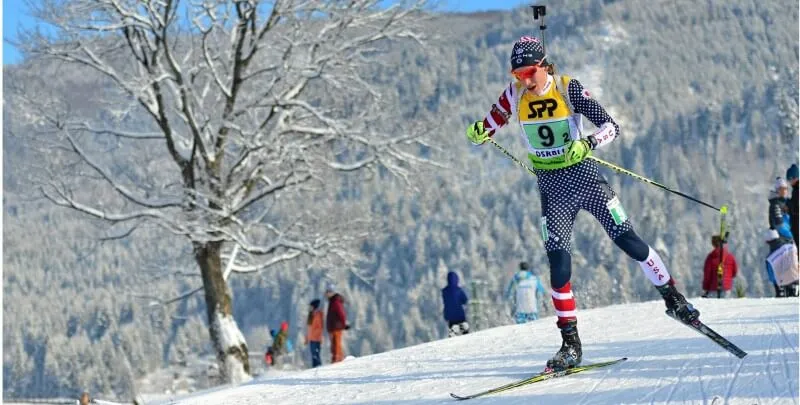Imagine skiing through the woods as fast as you can with a rifle on your back. Abruptly, you stop, pull the gun from its harness and stand perfectly still, controlling your breathing as you aim and rapid-fire towards five targets. You quickly slide the rifle into the harness and sprint off on your skis. This is biathlon.
Excelling in biathlon requires extreme aerobic exertion paired with motionless calm and precision. Biathletes prepare for two completely different sports, striving for good technique, intentional athletic training and proper care of injuries.
When athletes competing in the Youth/Junior Biathlon World Championships in Osrblie, Slavakia, this winter needed advice for relieving tight shins or treatments for back pain, they turned to professor Karen Westervelt.
A physical therapist and certified athletic trainer whose 17-year-old son, Bjorn Westervelt, competed in the event, Westervelt accompanied Team USA to Osrblie as a volunteer. Youth and junior athletes (age 17-21) from 35 countries and four continents competed in 16 different disciplines of biathlon.
Westervelt teaches biomechanics and kinesiology to exercise science and athletic training students and musculoskeletal evaluation and treatment to students in the Doctor of Physical Therapy program. She also serves as educational program director for UVM Integrative Health.
As a physical therapist, Westervelt treats patients with musculoskeletal injuries at a clinic in Stowe, Vermont.
Treating high-performance athletes during a competition is different than working in the clinic, said Westervelt, who found herself evaluating injuries in the waxing hut or at the finish line. High-level cross-country skiers are prone to overuse injuries, and many athletes suffer from the same conditions, she said.
"I took athletes to the gym each evening to treat injuries and work on techniques. The days are long preparing athletes for competition in the morning, being out of the course during the races, and treating injuries well into the evenings so that they can race again the next day. The work is incredibly rewarding! Athletes are a highly motivated population to work with,” Westervelt said.
“Providing volunteer physical therapy and athletic training support for Team USA at the Biathlon Youth and Junior World Championships is an honor for me. These athletes are the very best in the USA and they are really serving as ambassadors for the sport and our country as they complete on the world level. Keeping them healthy and on the snow is the way I can contribute to this purpose.”
In one instance, Westervelt helped relieve an athlete’s ankle pain so she could continue to compete. “She had an ankle sprain that was only 50% recovered and still causing her pain during skiing. We found a way to tape it to relieve the pain and still fit in her ski boots. She ended up doing really well in the races. She was so grateful. I showed her how to tape it herself so she could show her athletic trainer at home and continue taping it until her ankle fully recovers.”
Westervelt worked side-by-side with USBA junior coaches Danika Frisbie ’13, Tim Burke and Algis Shalna, observing athletes’ technique and conducting biomechanical analyses. An avid Nordic skier, Westervelt enjoys combining her knowledge of skiing, biomechanics and physical therapy to help athletes get back onto the snow as quickly as possible.
“Everyone wins when medical staff, who understand the biomechanics of human motion and mechanisms of injuries, collaborate with coaching staff, who understand technique and training principles. Together we can build faster, stronger, healthier high-performance athletes," Westervelt said.
In the classroom, Westervelt’s students appreciate listening to her experience traveling with Team USA as they learn about mid-season care for high performance athletes.
“I can see I have hit the target when students begin to realize that they can combine their love of sport with what they are learning in the classroom," she said. "All of a sudden, the motivation to learn becomes tangible.”
